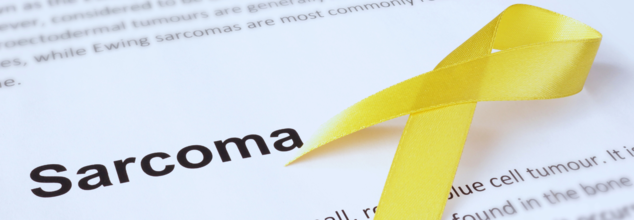- Health Conditions A-Z
- Health & Wellness
- Nutrition
- Fitness
- Health News
- Ayurveda
- Videos
- Medicine A-Z
- Parenting
The Body’s Own Fabric Turns Fatal: What You Need to Know About Sarcomas

When we talk about cancer, breast, lung, and colon usually dominate the conversation. But lurking quietly in the background is a lesser-known, often overlooked type: sarcomas. These rare cancers, which take root in connective tissues, don’t always get the attention they deserve. Yet, they deserve it and how.
Not Just One, But Many Types
Sarcomas are a group of cancers which arise from body tissues. It can be from bone, fat, muscle, tendons, nerves, blood and lymph vessels are the predominant ones.
Unlike most other cancers that generally strike older adults, sarcomas don’t discriminate by age. “These cancers can occur in relatively younger age groups,” Dr. Karthik K S, Consultant, Surgical Oncology at KMC Hospital, Mangalore, says. Sometimes, these are also triggered by certain genetic mutations, making them all the more complex.
The Trouble with Tumours
These tumours can quietly grow in any part of the body, which means the symptoms are often subtle and deceptive. Dr. Karthik says, “Presentations may be much simpler than the consequences. Unplanned treatment may lead to rather grievous consequences.”
Because of the wide-ranging locations where sarcomas can appear, they often call for specialists across disciplines. “The treatment of these types of cancers will need specialised doctors, often oncologist surgeons, medical and radiation oncologists,” he explains. In short, a generalist approach just won’t do.
Diagnosis: More Than Just a Scan
Before treatment even begins, the real detective work starts. “The patient will need a full evaluation,” says Dr. Karthik. That begins with imaging, but even this depends on where the sarcoma has taken hold. Once imaging has painted a picture, a biopsy is essential. “These diseases need a biopsy to prove the diagnosis and often subclassify the disease based on IHC (immunohistochemistry),” he says.
If there’s a suspicion of hereditary involvement, genetic studies may also be required. Only once everything is on the table—stage, type, and location—can doctors chalk out a treatment plan.
Surgery Takes the Lead
According to Dr. Karthik, “treatment includes surgery as a main modality of treatment.” But it’s rarely a one-man show. “Treatment may also include chemotherapy and radiotherapy,” he adds, making it a team effort from start to finish.
Kids Are Not Spared
Dr. Sachin Sekhar Biswal, Medical Oncology Consultant at Manipal Hospital, Bhubaneshwar, draws attention to another critical aspect: age is no protection. “Connective tissue is an important constituent of the human body. The cancer that arises from the connective tissue mostly constitutes sarcoma. It can be seen in all age groups, starting from infancy to geriatric populations.”
In fact, in children, sarcomas are surprisingly common. “Rhabdomyosarcoma is the most common type of cancer in the children,” Dr. Biswal states. “Apart from that, osteosarcoma and Ewing's sarcoma are also common types of sarcomas in children.”
Symptoms
Since sarcomas can develop anywhere in the body, the symptoms can be vague or misleading. Dr. Biswal points out, “It can present as a progressively increasing swelling or a lump, bone overgrowth with pain, swelling or limitation in the range of motion, or simply a vague lump based on its location.”
Which is why early detection is tough and treatment becomes even more time-sensitive.
Teamwork Makes the Treatment Work
Dr. Biswal explains that sarcoma treatment is not a one-specialist show. “Sarcoma treatment is always a multimodality effort involving medical and surgical oncologists, orthopaedic oncologists, radiation oncologists, interventional radiologists, onco-pathologists and the rehabilitation team.”
He shares that the most common treatment plan includes “surgical excision followed by radiation or chemotherapy”. When it comes to bone or limb sarcomas, gone are the days when amputation was the only solution. “Limb salvage therapy rather than amputation is the new way. It can be achieved by high-quality implants or autografts,” he adds.
Speed Is Everything
Time really is of the essence. Dr. Biswal stresses, “Though rare, the tendency to metastasise is high, such that diseases like Ewing’s sarcoma are considered systemic from the very time of diagnosis.” In other words, even at diagnosis, it’s already a whole-body concern.
But with timely diagnosis and swift treatment, outcomes can be significantly improved. “A timely diagnosis and a prompt treatment can save a life and avoid much morbidity,” Dr. Biswal reminds us.
Taking Venlafaxine? Experts Flag Symptoms That Need Immediate Attention

Credits: Canva
People prescribed venlafaxine are being urged to stay alert to certain symptoms and side effects that may require medical advice from NHS 111 or their GP. Venlafaxine is a widely used SNRI antidepressant. It is mainly prescribed for depression, but doctors may also recommend it for anxiety disorders and panic attacks.
What Is Venlafaxine?
Venlafaxine, sold under brand names such as Effexor and Effexor XR, is a prescription antidepressant classified as a serotonin-norepinephrine reuptake inhibitor. It helps regulate mood by raising levels of serotonin and norepinephrine in the brain, chemicals that play a key role in emotional balance and mental stability.
Doctors Warn People Taking Venlafaxine
The medicine is usually taken as a tablet or capsule. It works by increasing levels of serotonin and noradrenaline in the brain, chemicals that help regulate mood. According to NHS guidance, venlafaxine tends to cause fewer side effects than older antidepressants. That said, it is not completely free of risks.
Most people begin to notice some improvement within one to two weeks, although it can take four to six weeks for the drug to have its full effect.
Venlafaxine Side Effects
Common side effects listed by the NHS include sweating, nausea, a dry mouth, and headaches. These are generally mild and often ease as the body adjusts to the medication.
However, there are other, more serious side effects that may need prompt medical advice. While these reactions are uncommon and affect fewer than one in 100 people, the NHS advises contacting 111 or a GP if they occur.
Venlafaxine Serious Side Effects
NHS advice says you should speak to your GP if you notice unexpected weight gain or weight loss, or sudden changes to your menstrual cycle. This may include spotting, bleeding between periods, or unusually heavy periods.
Patients are also advised to contact their doctor or NHS 111 without delay if they experience any of the following symptoms while taking venlafaxine:
- Yellowing of the skin or the whites of the eyes
- Bleeding gums
- Bruising that appears without explanation or continues to spread
- Thoughts of self-harm or suicide
- Muscle pain or weakness with no clear cause
- Breathlessness, or a heartbeat that feels fast, uneven, or irregular
- Intense feelings of elation, extreme excitement, or restlessness that makes it hard to stay still
- Changes in vision, including blurred eyesight or enlarged pupils
- Coughing up blood
- Blood in urine
- Persistent headaches along with confusion, weakness, or repeated muscle cramps
- Black or red stools, or blood in vomit, which may point to internal bleeding
Adenovirus Or Super Flu? Here Is How To Tell The Difference

Credits: Canva
As adenovirus cases continue to rise globally, health professionals have noticed that this potentially serious infection is sometimes being mistaken for another illness, what many are calling the ‘super flu’.
For those unfamiliar, adenovirus is a DNA virus that gradually affects a person’s upper and lower respiratory tract, as well as other organs. This can include the eyes, digestive system, and kidneys.
Adenovirus Or Super Flu?
According to Dr. Deborah Lee at Dr Fox Online Pharmacy, who spoke to Cosmopolitan: "It spreads when someone breathes in infected droplets, touches the virus and then rubs their eyes, or through the faecal-oral route (not washing hands properly after using the toilet)."
"It moves quickly in crowded spaces where people are close together." She added, "The virus is resistant to soap and many commonly used cleaning products."
Adenovirus: What Are The Symptoms?
The reassuring news about adenovirus is that most people recover within a week or two. Its symptoms are often similar to those of a common cold.
Typical signs include fever, runny nose, sore throat, cough, shortness of breath, and swollen lymph nodes in the neck. In more severe cases, patients may also experience conjunctivitis, ear pain, diarrhea, vomiting, stomach aches, or urinary tract infections.
Certain groups are at higher risk of serious illness. Dr. Lee notes, "Babies and children under five, older adults, pregnant women, and people with weakened immune systems are the most vulnerable."
Although adenovirus symptoms often resemble those of a typical flu, it’s important to know when someone is dealing with the flu—or worse, the current ‘super flu’ that’s circulating widely.
How Does Adenovirus Differ From The 'Normal' Flu?
One way to tell the difference is by how long someone is sick. Adenovirus tends to develop gradually, whereas the ‘normal’ flu often hits suddenly, with high fever and intense symptoms within hours, Lee explains. Common flu symptoms also include a high temperature (38–40°C), severe headache, and extreme fatigue.
Other key differences: adenovirus can occur throughout the year, while flu is mostly seasonal. Adenovirus can also cause pink eye and gastrointestinal problems like vomiting or diarrhea, but it’s less likely to lead to serious complications compared to flu.
What About The 'Super Flu'?
Doctors say it’s not only the regular flu that needs to be distinguished from adenovirus, but also the current ‘super flu,’ which is causing particularly dramatic symptoms.
This infection is caused by the H3N2 virus and tends to be more severe than typical winter illnesses, especially in the UK.
"Past data shows H3N2 has been linked to more hospitalizations and deaths from flu, especially among adults over 65 and young children, compared with other flu types," Lee explained. When comparing the ‘super flu’ to adenovirus, she notes that the symptoms are very similar.
However, she stresses that the ‘super flu’ is considered much more intense. Not only can your sore throat feel agonizing, but aches and pains may be strong enough to confine you to bed.
Adenovirus vs Super Flu: Symptoms Explained
While adenovirus and the so-called ‘super flu’ can feel very similar, there are subtle differences to watch for. Adenovirus usually develops gradually, with fever, cough, sore throat, runny nose, and sometimes pink eye or digestive upset. Most healthy individuals recover within a week or two. In contrast, the ‘super flu,’ caused by the H3N2 virus, hits hard and fast—high fever, intense body aches, severe fatigue, and an agonizing sore throat are common.
Both illnesses can affect vulnerable groups such as young children, the elderly, and immunocompromised individuals, but the super flu tends to bring more extreme symptoms that may require hospitalization. Understanding these distinctions can help people recognize the illness early and seek appropriate care.
Emotional Body Chart: Where Emotional Feelings Like Anxiety, Joy, And Anger Are Felt In Your Body

Credits: AI Generated
Have you ever described feeling “cold feet,” “a gut instinct,” or “a shiver down your spine”? These common expressions might seem trivial, but they reflect something real. Emotional body mapping can help explain why.
Just as anxiety or depression can show up as physical symptoms, our emotions often register in specific areas of the body. Emotions guide much of how we experience the world, yet many of us rarely stop to notice how they affect us physically.
If you struggle to put your feelings into words, learning how emotions manifest in the body can help you connect more deeply with yourself.
Where Are Emotional Feelings Felt In Your Body?
A 2014 study by Glerean and colleagues identified 13 emotions and the specific areas of the body they activate—or don’t. Similar to a heat map, warmer colors (red, orange, yellow) indicate increased activity, while cooler colors (blue, green, indigo) indicate decreased activity.
If these maps resonate with your own experiences, they can provide insight into how emotions influence your body and overall well-being.
How Was This Tested?
The researchers proposed that each emotion triggers distinct physical reactions. They asked 701 participants to shade regions on a body silhouette where they felt heightened or reduced activity in response to various stimuli.
These stimuli mirrored real-life experiences: clips from films, conversations, and unexpected facial expressions. Across the participant pool, emotions consistently affected similar areas of the body.
A follow-up study in 2018 by the same team found that the intensity of bodily sensations mirrored the intensity of the emotion in the mind. In other words, stronger physical feelings were linked with stronger mental experiences.
From this, researchers categorized feelings as:
- Negative (unpleasant): anger, fear, anxiety, shame
- Positive (pleasant): happiness, love, pride
- Other categories: illness, homeostasis, cognition
Few emotions, such as surprise, were found to be neutral. Participants also reported that pleasant and controllable states occurred more often than unpleasant and uncontrollable ones. Anyone who has experienced overwhelming anxiety or depression will recognize that feeling of being out of control.

Emotional Body Chart
Certain emotions trigger strong physical responses, often preparing the body for action, such as the fight-or-flight response.
- Happiness: This emotion lights up the body the most. Warm sensations spread throughout, especially in the head and chest, signaling energy, vitality, and a sense of well-being.
- Anger: Activation is intense in the upper body—the head, chest, and arms. The hands are especially bright, reflecting the impulse to clench fists or act aggressively.
- Fear: Like anger, it activates the head and chest (heart racing). However, the feet are cold (blue), suggesting blood is being redirected from the extremities to vital organs.
- Anxiety: Almost entirely focused in the chest, representing tightness, rapid heartbeat, or difficulty breathing.
- Love & Pride: Both emotions show strong activation in the chest and head, associated with warmth, heart swelling, or the sensation of “puffing up” the chest.
Deactivation Emotions (Mostly Blue):
These emotions involve a withdrawal of energy and sensation from the body.
- Depression: The most deactivated state. Limbs are entirely blue, showing heaviness, numbness, and a lack of energy to move. The torso shows very little activation.
- Sadness: A mix of responses. The chest and eyes show some activity (linked to crying or heartache), but the arms and legs are cool, reflecting slowing or weakening of the body.
Other Specific Reactions:
- Disgust: Activation is concentrated in the digestive system—the throat and stomach—indicating nausea or physical aversion.
- Shame: A complex pattern appears. The chest and cheeks are warm (blushing), while the extremities are cold, reflecting internal turmoil paired with external withdrawal.
Understanding where emotions manifest in the body can help us become more aware of our physical and mental states. From the warmth of happiness in the chest to the heaviness of depression in the limbs, our bodies carry the signals of our feelings. Paying attention to these sensations not only deepens self-awareness but can also guide us in managing stress, improving well-being, and responding to emotions more mindfully.
© 2024 Bennett, Coleman & Company Limited

